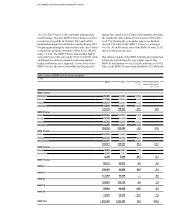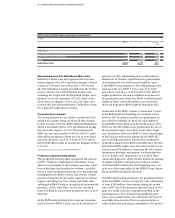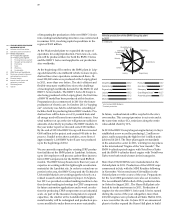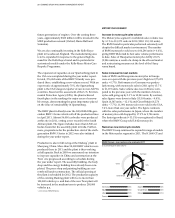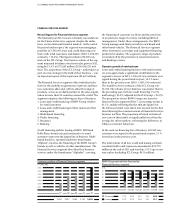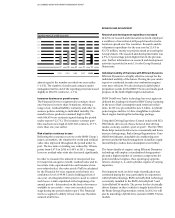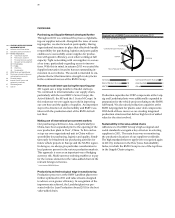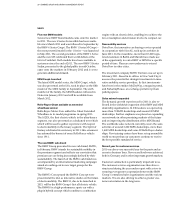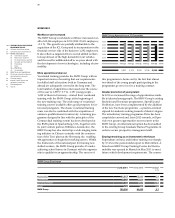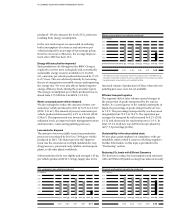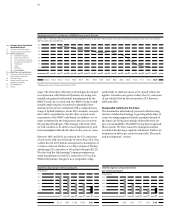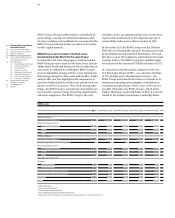BMW 2011 Annual Report Download - page 34
Download and view the complete annual report
Please find page 34 of the 2011 BMW annual report below. You can navigate through the pages in the report by either clicking on the pages listed below, or by using the keyword search tool below to find specific information within the annual report.
34
BMW has also implemented a number of key innova-
tions in the field of intelligent lightweight construction.
The latest examples of these are the doors, front side
walls and bonnet of the new BMW 5 Series. The doors
alone are 23 kilograms lighter per vehicle than their
predecessors.
Networking with Connected Drive
Connected Drive at the BMW Group stands for the whole
range of mobility services and driver assistance systems
used to optimise convenience, infotainment and safety
in the car through the intelligent networking of driver,
vehicle and environment.
With MINI Connected, in 2010 the BMW Group be-
came the first carmaker worldwide to offer the applica-
tion-based and comprehensive integration of the Apple
iPhone in its vehicles. This feature has also been avail-
able in the BMW range since spring 2011. The app
con-
cept enables the range of features provided within
the vehicle to be considerably extended. A third App-
Center, the BMW Group Connected Drive Lab China in
Shanghai, was established during the year under report,
alongside the AppCenters in Munich and the USA,
thus enabling us to develop apps for specific markets.
In autumn 2011, Real-Time Traffic Information (RTTI)
was added to the range of services available to customers
in conjunction with ConnectedDrive. RTTI relays real-
time traffic information with great precision, on both
main and secondary roads. Moreover, customers with
BMW ConnectedDrive contracts can now plan their
routes online before setting off on a journey. If the traf-
fic situation changes before the start of the journey and
the route planner recommends a new, earlier departure
time, the customer can arrange to be informed of the
update by e-mail.
The broad range of options available with Connected-
Drive was demonstrated in the BMW Vision Connected
Drive concept car displayed at the Geneva Motor Show.
The car and its functions are specifically designed to
cater to the needs of the driver and passenger. The fea-
tures incorporated in the BMW Vision ConnectedDrive
include an extended version of the Head-Up Display,
which shows information and symbols in a three-dimen-
sional display, resulting in a picture that merges virtual
content into the actual street scene. The Passenger In-
formation Display also allows the passenger to use the
additional options created by intelligent networking,
including the ability to assess information received on-
line via the navigation system and pass it on to the
driver’s instrument cluster.
BMW i 3 and i8 make world debut
In 2011 we presented the BMW i sub-brand as well as
the BMW i 3 and BMW i 8 concept cars. BMW i stands
for sustainable mobility in the premium segment and
coincides with our belief that premium cars are being
increasingly defined by their sustainability.
As the first BMW Group series-produced all-electric car,
the BMW i 3 Concept precisely defines the future chal-
lenges of mobility in urban environments. This vehicle,
which has been specially designed for electrically
powered driving, has a CFRP passenger compartment
and aluminium chassis and sets new standards in terms
of lightweight construction. Given that reduced weight
also means increased range, the i3 offers a decisive
benefit that will accelerate the broad acceptance of elec-
tromobility. The i3 will be 250 to 350 kilograms lighter
than a conventional electric car. The electric motor has a
capacity of 125 kW (170 hp), providing the car with a
top speed of 150 km / h. With seating for four people and
a boot volume of around 200 litres, the BMW i 3 Concept
is highly suitable for everyday use.
The BMW i 8 Concept is the world’s most progressive
sports car. With its plug-in hybrid concept, it combines
a combustion engine and an electric drive to produce a
car with extremely low fuel consumption and emission
levels. Whereas the front axle of the BMW i 8 Concept is
powered by the modified electric drive system
of the i3
(96 kW/ 129 hp), a 164 kW (223 hp) turbo-charged 3-cylin-
der
petrol engine propels the rear axle. Fuel consump-
tion is
2.7 litres per 100 kilometres in the European test
cycle, equivalent to CO2 emissions of 66 g / km.
The era of the electric car also demands new concepts
in terms of vehicle architecture and body design. The
LifeDrive concept of BMW i cars comprises two
horizon-
tally separated, independent modules. The Drive module
forms the car’s stable base and integrates battery and
drive system as well as the structural and basic crash
features. The Life module comprises mainly a high-
strength, lightweight passenger compartment made of
CFRP. The extensive use of this high-tech material re-
mains unique so far in the carmaking industry and am-
ply demonstrates our technological superiority in the
field of lightweight construction.
In order to carry out basic research in the next genera-
tion of lithium-ion battery technology, the BMW Group
and the Toyota Motor Corporation (TMC) intend to en-
ter into a medium- to long-term cooperation agreement.
The two companies signed a corresponding Declaration
of Intent in December 2011.
18 COMBINED GROUP AND COMPANY
MANAGEMENT REPORT
18 A Review of the Financial Year
20 General Economic Environment
24 Review of Operations
24 Automotive segment
29 Motorcycles segment
31 Financial Services segment
33 Research and development
36 Purchasing
37 Sales
38 Workforce
40 Sustainability
43 BMW Stock and Capital Market
46 Disclosures relevant for takeovers
and explanatory comments
49 Financial Analysis
66 Internal Control System and
explanatory comments
67 Risk Management
73 Outlook



